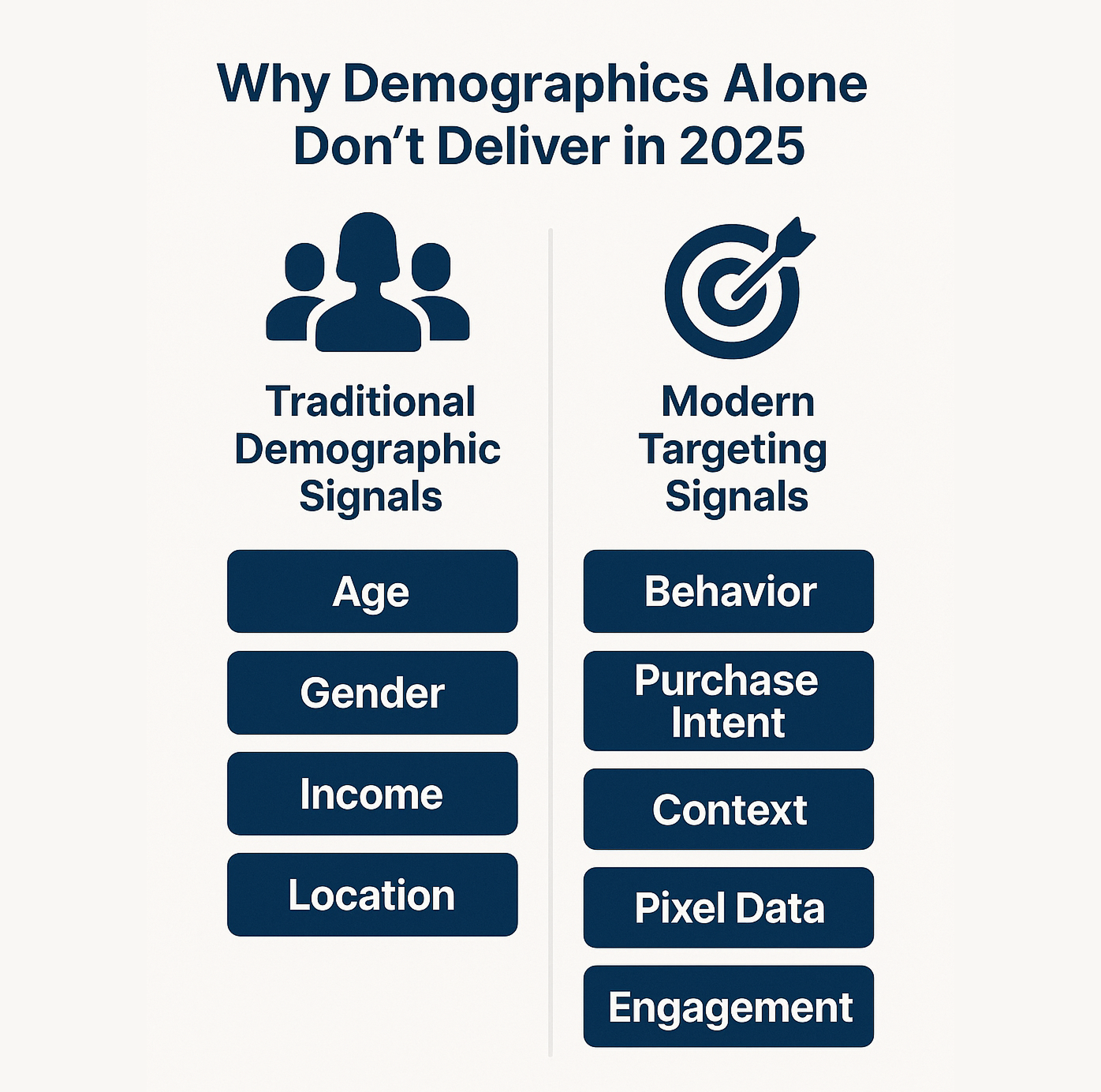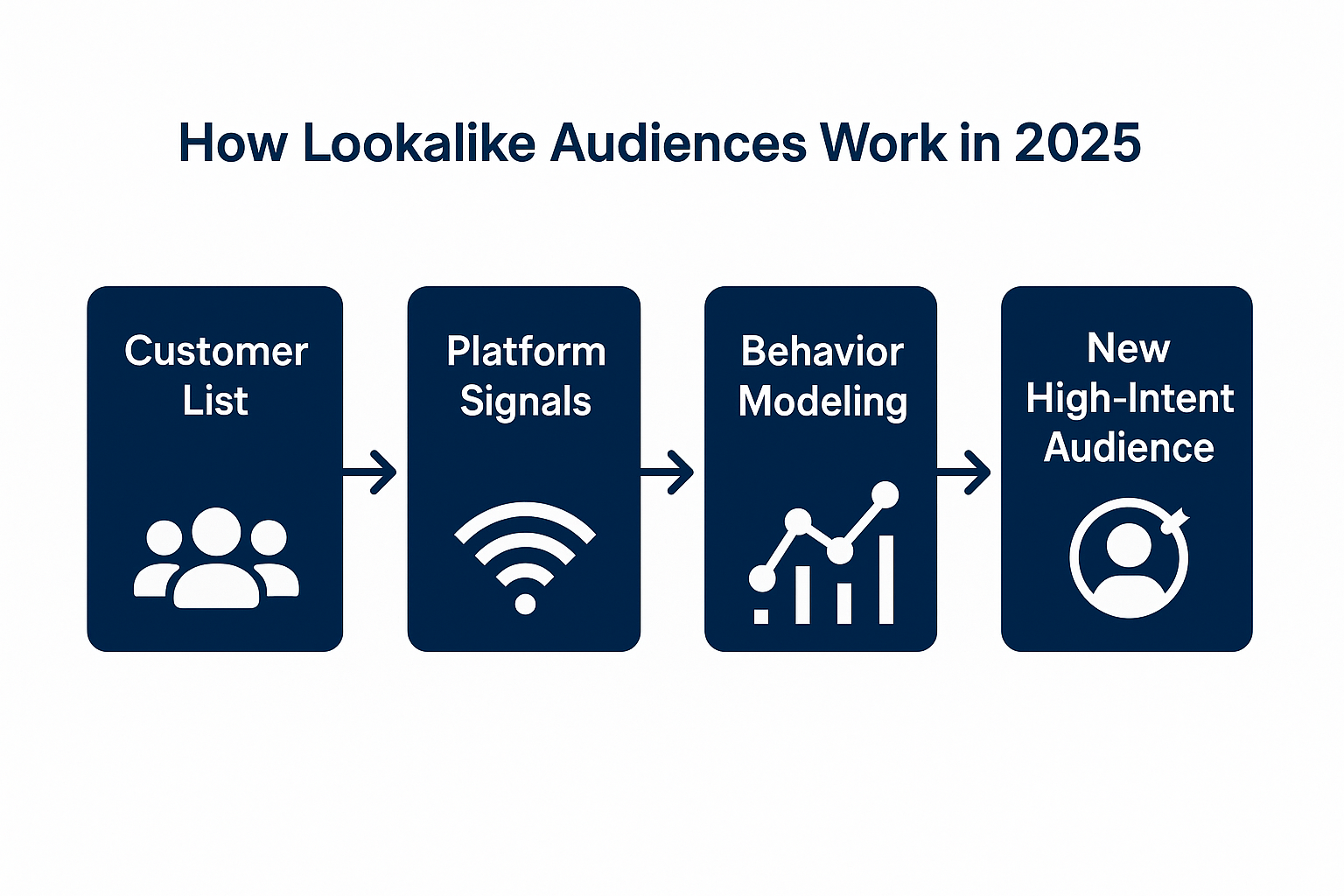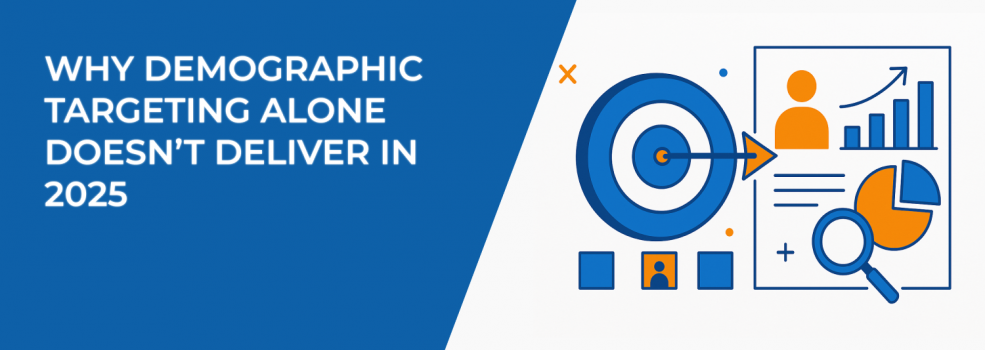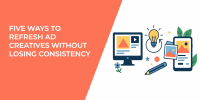Demographic targeting — age, gender, location — used to be the default starting point for every Facebook campaign.
But in 2025, it’s not enough.
Today’s ad platforms operate on far more advanced signals. They track behavior, interests, and intent in real time. Relying solely on static audience traits now means lower relevance, weaker performance, and often, wasted budget.
Here’s what advertisers need to understand — and what to do instead.
1. Demographics Don’t Reveal Intent
Knowing a user is a 30-year-old woman living in New York says nothing about her current needs or buying motivations. She could be a newly promoted manager looking for productivity software — or a new parent searching for sleep support tools.

Demographics only show broad labels. Intent lives in behavior.
Instead of grouping people by generic traits, aim to understand:
-
Their current goals. Are they researching how to save money or looking for tools to grow a business?
-
Their digital journey. Have they visited your pricing page, read product reviews, or clicked a comparison ad?
Example: Instead of targeting “males, 25–34, USA,” create an audience based on people who’ve visited your “Plans & Pricing” page in the past 14 days. This shows they’re not just demographically suitable — they’re interested right now.
For a full process, read: How to Define a Target Audience for Marketing.
2. Behavior Now Outweighs Demographics
Ad platforms now track behavior across hundreds of touchpoints — from website interactions to app activity and even social media engagement.
Instead of targeting based on “who they are,” focus on what they’re doing.
Here’s what behavioral targeting might include:
-
Click activity: People who clicked on competitor ads or product comparisons.
-
Watch time: Users who watched 75% or more of your product demo video.
-
On-site engagement: Users who added a product to their cart but didn’t complete the purchase.
Example: If someone browses three different CRM software reviews and clicks on a “best tools for sales teams” blog, you’re far better off targeting them based on that behavior than on their age or job title.
Behavior-based ads consistently outperform static audience sets — especially for e-commerce and SaaS brands. See this in action here: Behavior-Based Facebook Targeting: The Secret Weapon.
3. Over-Targeting Can Hurt Performance
Many marketers try to hyper-refine their audiences, assuming smaller = better. But over-targeting limits reach, raises costs, and gives Meta’s algorithm less room to learn.
Common problems when over-targeting include:
-
Low impressions: Your ad doesn’t get served because the audience is too narrow.
-
Higher CPMs: Fewer people available to see your ad = more competition = higher prices.
-
Delivery issues: You might see warnings like “Ad Set May Get Zero”, meaning the audience is too restrictive for Meta to serve efficiently.
Example: An ad set targeting “women, age 30–45, living in Denver, who like Mailchimp, use an iPhone, read Adweek, and run a Shopify store” is likely to underperform. The audience is too specific, even if each filter seems relevant.
4. Lookalike Audiences Are Smarter Than Ever
Lookalike audiences allow Meta to find users who behave like your best customers — not just look like them on paper. They work by analyzing patterns across hundreds of signals, including purchase behavior, content preferences, and platform activity.

Use this approach when you have:
-
A quality source audience: Like past buyers, high-LTV customers, or webinar attendees.
-
A clear conversion goal: Like lead form submissions or completed checkouts.
Example: Upload a CSV of customers who bought from you in the last 90 days. Meta can create a lookalike audience of 1–5% similarity — meaning these users share behaviors with your buyers, even if their age or gender differs.
You can refine lookalikes further by layering in interests or behaviors — like “lookalike of buyers + visited pricing page.”
Get a full walkthrough in: Custom vs Lookalike Audiences: What Works Best.
5. Context and Timing Matter More Than Ever
You can target the right user — and still lose — if you catch them at the wrong time or in the wrong context.
That’s why modern targeting strategies now include environmental signals:
-
Device type: Desktop users might convert better for B2B services, while mobile users favor impulse purchases.
-
Time of day: Some products perform better during lunch breaks or evenings.
-
Day of week: Campaigns often perform differently on weekends vs weekdays.
-
Ad placement: Someone scrolling Reels vs someone browsing Marketplace is in a very different mindset.
Example: A productivity tool aimed at business owners might perform poorly if shown on mobile during late-night hours — but see strong conversions mid-morning on desktop with Messenger placement.
You can use detailed targeting for micro-niche audiences to adapt your campaign based on these contextual clues.
What to Focus on Instead
In 2025, successful ad strategies rely on combining behavior, platform signals, and real-world data. Here's what the best advertisers are doing:
-
Use custom audiences from real customer data, such as email lists, webinar sign-ups, or CRM exports. For example, you can upload a segment of loyal customers to create a high-quality seed for lookalike generation.
-
Build behavior-triggered segments based on how users engage with your site or content. E.g., retarget users who spent 3+ minutes on your pricing page but didn’t convert.
-
Test multiple hooks and creatives before scaling, using small daily budgets to avoid burning spend. You can launch 3 micro-campaigns with different angles (“free trial,” “limited offer,” “social proof”) and scale the winner.
-
Combine interest targeting with exclusions to refine reach without over-restricting. For example, you can include “email marketing tools” interest but exclude “freemium tool users” if targeting high-paying SaaS buyers.
-
Leverage AI-powered campaign tools to dynamically optimize targeting over time. Here, you can try Meta’s Advantage+ campaigns or predictive tools. Learn how in this guide: Testing AI-Powered Facebook Ad Tools.
Final Thought: Demographics Still Have a Role — But a Limited One
Use demographics for basic boundaries — like excluding minors, narrowing by region, or separating broad funnel stages.
But they shouldn’t be the foundation of your strategy.
In 2025, relevance comes from real behavior, smart testing, and adaptive targeting. The platforms are designed to optimize — your job is to give them enough space and signal to do it well.

